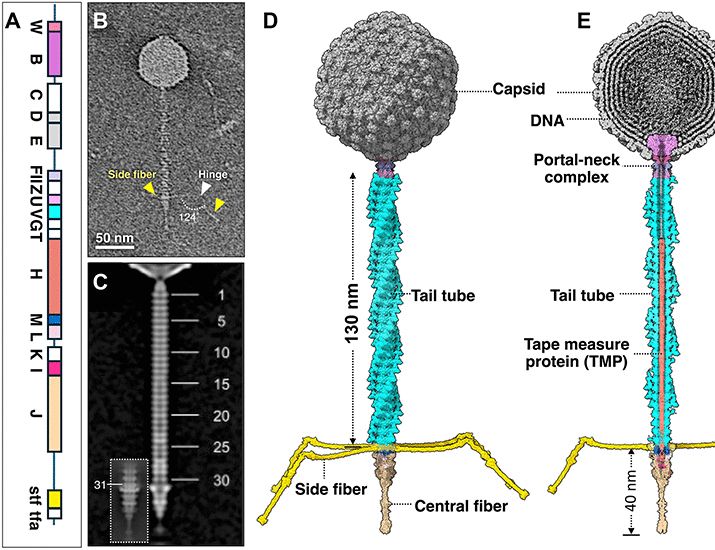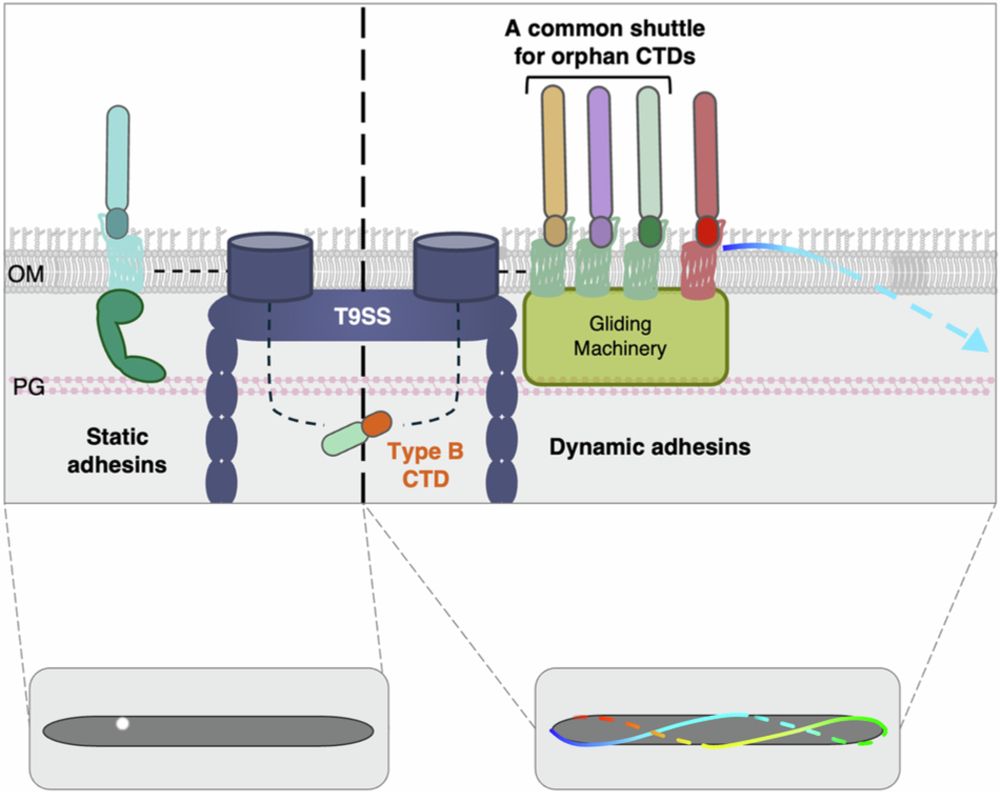
Impact of Pseudomonas aeruginosa biofilm exopolysaccharide composition on bacteriophage and bacteriophage-antibiotic combination activity
in AAC
journals.asm.org/doi/10.1128/...
@fillouxlab.bsky.social

Impact of Pseudomonas aeruginosa biofilm exopolysaccharide composition on bacteriophage and bacteriophage-antibiotic combination activity
in AAC
journals.asm.org/doi/10.1128/...

Please RT. Post-doc opportunity alert! 💥 closing soon 10th December.. Come join our team (www.thelowlab.org) at Imperial, London, working on the structure and mechanism of bacterial secretion systems.
For more details and to apply please see
www.imperial.ac.uk/jobs/search-...

Phage resistance mutations in a marine bacterium impact biogeochemically relevant cellular processes | Nature Microbiology https://www.nature.com/articles/s41564-025-02202-5
04.12.2025 22:56 — 👍 2 🔁 1 💬 0 📌 0
Viruses are found in almost every ecosystem across the planet.
Now, researchers have released VIRE – a comprehensive viral genome database covering diverse ecosystems to advance understanding of viral evolution and ecosystem functions.
Learn more: www.embl.org/news/science...

It's beginning to look a lot like...
Microbial Christmas!
🦠🧫🔬🎄🎅🏻🛷🦌☃️

A sketched inference for the dilution at the complexity threshold and potential compositions of sub-communities after cultivation.
Microbiology Monday: Who becomes dominant in a microbial community? Competitive traits nominate species, but rare microbes “vote” the winner through complex interactions. Learn more in #mBio: asm.social/2Ib
01.12.2025 17:42 — 👍 9 🔁 4 💬 1 📌 1want to see a chemotaxis array (G) and a post-discharge T6SS (I) ? inside 𝘝𝘪𝘣𝘳𝘪𝘰 𝘧𝘪𝘴𝘤𝘩𝘦𝘳𝘪 inside a 𝘌𝘱𝘳𝘺𝘮𝘢 𝘴𝘤𝘰𝘭𝘰𝘱𝘦𝘴 crypt ? go no further...
#CryoET #CryoEM #teamtomo #MicroSky

On the left, the wild-type bacterium Salmonella enterica strain forms an initial, unstructured biofilm that looks like a shade of blue. As genetic changes ripple through the population, we see a more structured, resilient, and visually distinct biofilm pattern on the right that looks like a web of blue on a white background.
What does a biofilm look like? 🧫
Dr Eleftheria Trampari's photo, titled "Making waves", recently won 3rd prize at the Biofilm Create! Competition 🥉
📸 Zeiss AxioZoom V16 with support from the Advanced Microscopy team
buff.ly/ZuyytCo

Registration is open for the SJINML Public Lecture with Dr Margaret McFall-Ngai: The Power of Symbiosis in Shaping Our Biosphere. If you’ve wondered about sustainability or if probiotics really work, this talk may have the answer.
3 Dec, SMU. Light refreshments available.

JB Editor's Choice: Panich, Wadhwa et al. describe a new type of motility in Salmonella they refer to as "swashing", which does not appear to require active propulsion.
journals.asm.org/doi/10.1128/...
@asm.org #JBacteriology

Our final issue of 2025 has gone live!
🫁pertussis prevention
🏭pollutants and gut bacteria
🕳️porins and resistance in E. coli
🧬many flavours of CRISPR
🦟fatal fungal attraction
...and more 👇
www.nature.com/nmicrobiol/v...

This day, November 30th 2025, it is official, 40th anniversary. Had to celebrate in style
01.12.2025 05:13 — 👍 13 🔁 1 💬 1 📌 0
Gut Microbiota Imbalance Linked to Rapid Global Rise in IBD
#Gastrosky #gastroenterology
www.emjreviews.com/gastroentero...

The host range of generalist and specialist phages in capsule-diverse Klebsiella hosts is driven by the evolvability of receptor-binding proteins
@plosbiology.org from @pilardomingoc.bsky.social
journals.plos.org/plosbiology/...
Cheers
27.11.2025 23:42 — 👍 1 🔁 0 💬 0 📌 0

Incredibly insightful talk this afternoon by @matthewjshepherd.bsky.social speaking about within-patient ciprofloxacin resistance in P. aeruginosa #MicroEvo25
27.11.2025 15:16 — 👍 16 🔁 5 💬 1 📌 0
Type VII ABC transporters underpin many core activities in the bacterial cell envelope - including efflux, cell division and lipoprotein trafficking.
A new paper in PLOS Biology reveals YbbAP-TesA as a novel Type VII system in E. coli.
dx.plos.org/10.1371/jour...

Excited to share our latest research in @natmicrobiol.nature.com . We uncover hundreds of inhibitory interactions between common chemical pollutants and human gut bacteria. A thread🧵 (1/10) #microbiomesky #microsky @kiranrpatil.bsky.social lab @mrc-tu.bsky.social www.nature.com/articles/s41...
26.11.2025 10:29 — 👍 59 🔁 22 💬 2 📌 3Want to see something that will fry your brain? Disappearing reappearing plaques on P aeruginosa @dominickfaith.bsky.social
🧫🦠🧪

In Melbourne for a symposium organized by the ARC Biofilm Research and Innovation Centre. It was really nice to be welcomed by my colleague and friend @abdou-hachani.bsky.social
24.11.2025 20:09 — 👍 10 🔁 1 💬 0 📌 1
Woman standing in front of a slide describing why antimicrobial resistance and antibiotic access is an urgent threat to human sustainability
Fortuitous timing for my NTU-SBS seminar to land in World Antimicrobial Awareness Week #WAAW. I took the opportunity to showcase our research into alternate bacterial lifestyles and how we are leveraging this understanding to develop innovative approaches to combat AMR
🧫🧪
@scelse.bsky.social

Streptomyces formicae was isolated from Tetraponera penzigi plant-ants and has bioactivity against Gram-positive pathogens due to the production of formicamycins.
Read the latest Microbe Profile on Streptomyces formicae KY5: an ANT-ibiotic factory. Published Open Access and fee-free in Microbiology using a Publish and Read agreement: doi.org/10.1099/mic.... #MicrobioJ #PublishAndRead
22.11.2025 02:32 — 👍 6 🔁 3 💬 1 📌 0
Our latest T7SS study is now out in Science Advances!
We solved the cryoEM structure of the T7SSb core unit (T7bCU) composed of YukB, YukC, and YukD from Bacillus subtilis, revealing how these components assemble within the secretion machinery.
www.science.org/doi/10.1126/...




Two intense days underscored SCELSE’s strength in true multi-disciplinarity — broad enough to collaborate, deep enough to push boundaries. A retreat filled with ideas across health, climate, and food. Kudos to Prof Whitchurch @cwhitch.bsky.social for organising a strong event.
20.11.2025 07:45 — 👍 3 🔁 2 💬 0 📌 0
#microsky #phagesky
Structure of phage Ur-lambda
www.science.org/doi/10.1126/...

Collage with headshots of ten individuals with a message announcing 'Prize Winners 2026 – Presenting at Annual Conference 2026.'
The Microbiology Society is pleased to announce the winners of our 2026 Prizes! The winners will be awarded and deliver Prize Lectures at Annual Conference 2026 in Belfast from 13–16 April. Find out more about it: microb.io/PrizeWinners.... Meet the winners below. #Microbio26
19.11.2025 14:56 — 👍 30 🔁 15 💬 3 📌 3
A man and a woman standing behind a table. On the table is a microscope showing an image of biofilm-infected tissue, a robotic ventilator and various items of lab equipment.
Here’s @tosinorababa.bsky.social & @nreddy.bsky.social showing the ways we grow bacteria in the lab to simulate conditions in an infected patient - we have models of #CysticFibrosis lung, endotracheal tube & chronic wound, all compliant with efforts to reduce & replace animals in research.
19.11.2025 19:39 — 👍 12 🔁 2 💬 1 📌 1
SCELSE’s annual Scientific Retreat begins tomorrow. Two days of presentations, posters, and breakout discussions will sharpen the next phase of our biofilm and microbiome research aligned with the UN Sustainable Development Goals. @cwhitch.bsky.social @fillouxlab.bsky.social
17.11.2025 11:59 — 👍 3 🔁 2 💬 1 📌 0
Happy to share the last paper form the lab:
Specialized shuttle proteins recognize
T9SS signals and target
effectors to their final destinations. Great work by @maellepllt.bsky.social, led by @thicoz.bsky.social in collaboration with @audebertstephane.bsky.social
www.nature.com/articles/s42...

Assembly, architecture and functional roles of microbial surface layers
Review article published in @natrevmicro.nature.com with @bupbuse.bsky.social, Andriko von Kügelgen and @vikramalva.bsky.social.
S-layers are everywhere!
www.nature.com/articles/s41...